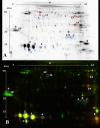Differences in sperm protein abundance and carbonylation level in bull ejaculates of low and high quality
- PMID: 30427859
- PMCID: PMC6241115
- DOI: 10.1371/journal.pone.0206150
Differences in sperm protein abundance and carbonylation level in bull ejaculates of low and high quality
Abstract
In breeding and insemination centres, significant variation in bull ejaculate quality is often observed between individuals and also within the same individual. Low-quality semen does not qualify for cryopreservation and is rejected, generating economic loss. The mechanisms underlying the formation of low-quality ejaculates are poorly understood; therefore, the aim of the present study was to investigate the proteomic differences and oxidative modifications (measured as changes in protein carbonylation level) of bull ejaculates of low and high quality. Flow cytometry and computer-assisted sperm analysis were used to assess differences in viability, reactive oxygen species (ROS) level, and sperm motility. To analyse changes in protein abundance, two-dimensional difference gel electrophoresis (2D-DIGE) was performed. Western blotting in conjunction with two-dimensional electrophoresis (2D-oxyblot) was used to quantitate carbonylated sperm proteins. Proteins were identified using matrix-assisted laser desorption/ionisation time-of-flight/time-of-flight spectrometry. High quality ejaculates were characterised by higher sperm motility, viability, concentration, and a lower number of ROS-positive cells (ROS+). We found significant differences in the protein profile between high- and low-quality ejaculates, and identified 14 protein spots corresponding to 10 proteins with differences in abundance. The identified sperm proteins were mainly associated with energetic metabolism, capacitation, fertilisation, motility, and cellular detoxification. High-quality ejaculates were characterised by a high abundance of extracellular sperm surface proteins, likely due to more efficient secretion from accessory sex glands and/or epididymis, and a low abundance of intracellular proteins. Our results show that sperm proteins in low-quality ejaculates are characterised by a high carbonylation level. Moreover, we identified, for the first time, 14 protein spots corresponding to 12 proteins with differences in carbonylation level between low- and high-quality ejaculates. The carbonylated proteins were localised mainly in mitochondria or their immediate surroundings. Oxidative damage to proteins in low-quality semen may be associated with phosphorylation/dephosphorylation disturbances, mitochondrial dysfunction, and motility apparatus disorders. Our results contribute to research regarding the mechanism by which low- and high-quality ejaculates are formed and to the identification of sperm proteins that are particularly sensitive to oxidative damage.
Conflict of interest statement
The authors have declared that no competing interests exist.
Figures



References
-
- Oliveira LZ, de Arruda RP, de Andrade AFC, Celeghini ECC, dos Santos RM, Beletti ME, et al. Assessment of field fertility and several in vitro sperm characteristics following the use of different Angus sires in a timed-AI program with suckled Nelore cows. Livest Sci 2012;146:38–46. 10.1016/j.livsci.2012.02.018 - DOI
-
- Sudano MJ, Crespilho AM, Fernandes CB, Junior AM, Papa FO, Rodrigues J, et al. Use of bayesian inference to correlate in vitro embryo production and in vivo fertility in zebu bulls. Vet Med Int 2011;2011:436381 10.4061/2011/436381 - DOI - PMC - PubMed
-
- Correa JR, Pace MM, Zavos PM. Relationships among frozen-thawed sperm characteristics assessed via the routine semen analysis, sperm functional tests and fertility of bulls in an artificial insemination program. Theriogenology 1997;48:721–31. 10.1016/S0093-691X(97)00296-3 - DOI - PubMed
-
- Netherton J, Hetherington L, Ogle RA, Velkov T, Baker M. Proteomics analysis of good and poor quality human sperm demonstrates several proteins are routinely aberrantly regulated. Biol Reprod 2018;99:395–408. 10.1093/biolre/iox166 - DOI - PubMed
Publication types
MeSH terms
Substances
LinkOut - more resources
Full Text Sources

